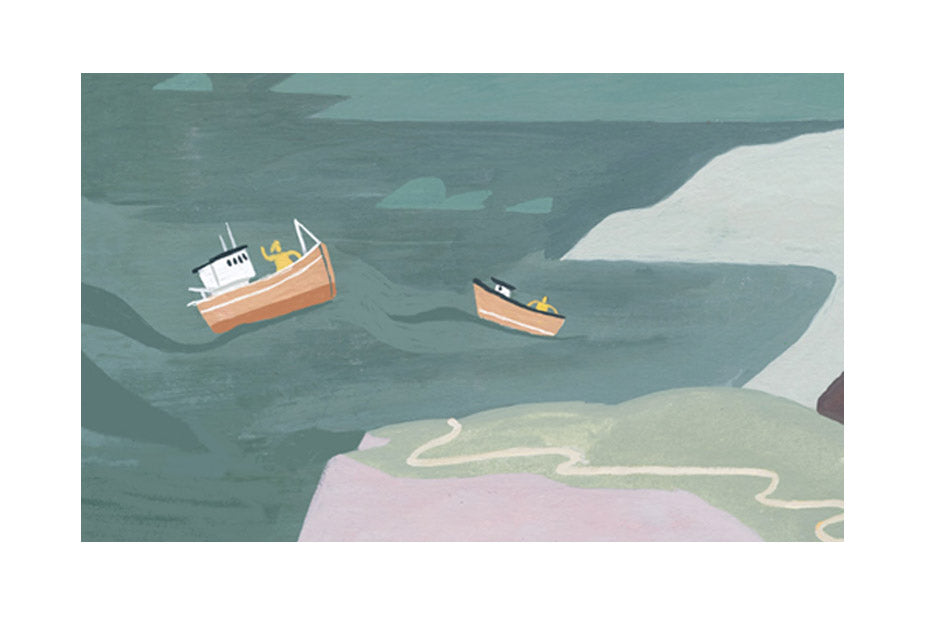There is no raincoat quite so iconic as a fisherman yellow raincoat.
Over the past few years, this rubberised rain jacket has outgrown its roots of purely practical necessity and worked its way into both high street and designer styling. Fisherman fashion is everywhere. Everyone, from tiny, welly boot clad tots, to teens and ladies, can now sport a bright yellow, rubberised raincoat and look good doing so.
Lighthouse love raincoats; they’re our speciality. When you’re based in rainy Northern Ireland you quickly understand how important it is to have a good, hardwearing waterproof on hand. It was from this same understanding that the Scots of the 19th century accidentally created the traditional yellow of the fisherman’s coat, an unanticipated addition to an easy method of waterproofing.
The earliest yellow rain jacket can be traced back to a linen mill somewhere along the coast of Scotland. This mill crafted linen sails for clippers - fast sailing ships that transported goods along the trade routes of Britain. The flax from which linen is produced seeps an oil from its seeds during the linen’s production. This oil was robust enough to be used as a waterproof coating for sailcloth - the material used for seamen’s clothing - and so it was painted onto this cloth as a means of protection for the fishermen against the sea spray and bad weather.

These early sailcloths were initially crafted into capes. The linseed oil coating made them fully waterproof, but after cold and blustery days at sea, the material became a burden, growing stiff and heavy after extended exposure to the elements. The oil also aged the material in a strange way, and the capes grew discoloured and yellow. This accidentally yellow rainwear, synonymous to the first fishermen, was known as oilskins or ‘slickers’.
Years passed, however, and the impracticality of the fishermen’s linseed covered capes became more and more apparent. In Glasgow in 1823, a young chemist called Sir Charles Macintosh began developing a fabric that he hoped would be just as robust as these oilskins, but offer a less burdensome method of waterproofing. He stuck together layers of naphtha (a solvent produced from tar) and rubber, sandwiching them between strips of cloth for the coat’s outer fabric. Although it was by no means perfect, this new fabric proved itself to provide an effective level of rain cover. It was altogether less weighty than the waterproofing methods of the past, and it was more suited for mass production.
Work continued on this new fabric, ensuring that it remained in tact when seamed, didn’t become stiff in the cold, and didn’t melt with any rise of temperature. Eventually, around the year 1840, after much trial and error, it was noted that the fabric was most effective when vulcanised. This meant that that it was treated with sulphur at a high temperature until it became hardened. Macintosh, along with his new business partner, Thomas Hancock, were the first to experiment with this method of patenting. It is from this discovery that the term ‘mackintosh’, referring to waterproofed, rubberised coats, was derived.
Soon, rubberised outerwear spread down from the Scottish highlands into mainland England. Before long, this kind of waterproofing (along with waxing cotton) became a standardised method of rain proofing coats and trousers. It was no longer just fishermen that sought more practical rainwear, but those who desired riding jackets, railway workers, the UK police forces, and even the British Army. For the seamen, the yellow colouring seemed to stick. It was ideal for increasing the visibility of the fishermen in the event of fog or stormy seas, along with being altogether more practical and lightweight. As a result, yellow rubberised raincoats became iconically coastal.
 Illustration: Pádhraic Mulholland
Illustration: Pádhraic Mulholland
We don’t often refer to our raincoats as mackintoshes anymore (nor do we debate where the letter k snuck into the title). The sister brand to Lighthouse, Mac in a Sac, is as close as we often get to considering our outwear as a kind of mackintosh. In any case, heritage fashion, however we term it, is always on trend.
Many contemporary brands provide a lovely selection of yellow raincoats for women. There is no doubt that they are in-style and as popular as ever.
For Lighthouse the Autumn Winter season brought Iona, a cosy, Autumnal reimagining of this much loved colourway and style. But also Raven, a more vibrant option of this nautically inspired coat, perfect for fighting off the dull Winter days.
New arrivals for Lighthouse Spring Summer 19, is an iconic yellow rubberised raincoat, Bowline Short in Soft Sun. We've also added a beautiful soft sun colour way to our essential raincoat style, Beachcomber.
Whilst it’s hard to say when rubberised yellow raincoats first came back into mainstream fashion, there’s no doubt that they’re here to stay. Shop our website to find your style!



